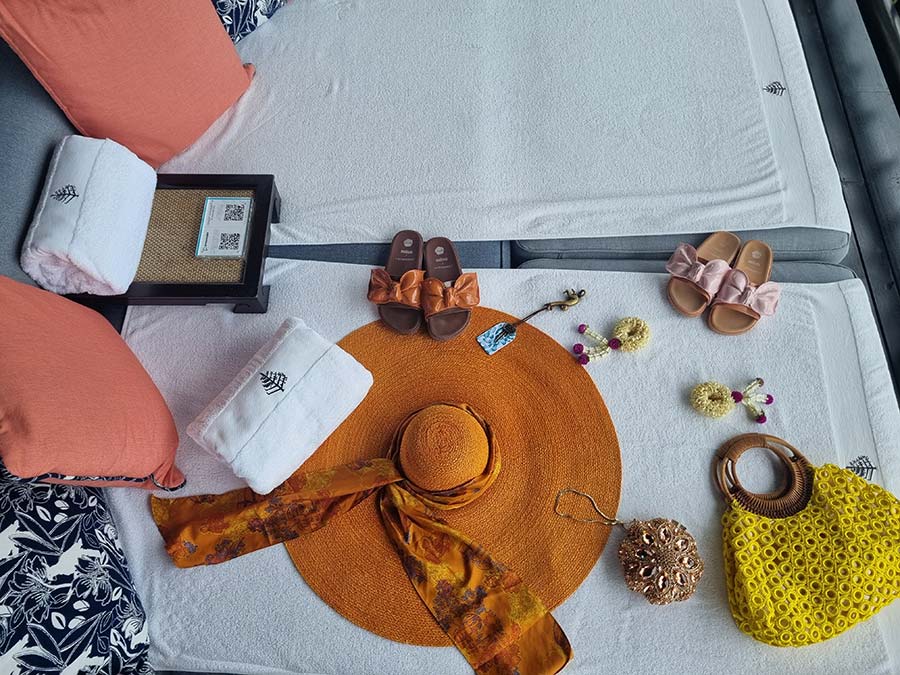Plastic has long been seen as a harmful substance to the environment. However, the shoe brand Melissa challenges this perception and suggests that plastic may not be as detrimental as we believe.
There is currently a significant discussion surrounding the environmental impact of the fashion industry and the practices that contribute the most to this issue during the climate crisis. Many people envision a better future and contemplate how fashion brands could make positive changes if certain conditions were met. However, I no longer have to imagine such a utopian scenario because I have personally witnessed the existence of a company that embodies these ideals.
I opted for Barbie pink, to get into the Barbie Movie mood. I grew up with Barbie and that will always be my inspiration for wearing pink.


Melissa is a well-known brand that created the original jelly sandals, which were popular in the 1990s. However, many people are not aware that the brand is now leading the way in producing sustainable and ethical fashion.


100 Percent Recyclable Products
Melissa is a leading footwear producer that stands out for its commitment to sustainability. Not only does Melissa manufacture 100 percent recyclable products, but it does so in a zero-waste facility powered by renewable energy. Moreover, Melissa has implemented an entirely closed circuit of production. As one of the largest footwear producers globally.
Melissa has successfully produced over 32 million pairs of shoes in the past decade. Achieving waste reduction at this scale is a significant accomplishment.

I ride my electric motorbike in these pink plastic shoes in Hoi An Vietnam, the street style fashion is amazing and I get so many compliments with my Barbie pink Melissa heels. They are very comfortable too and perfect for the heat.
Four Seasons Resort Koh Samui Thailand
Whilst working at the Four Seasons Resort in Koh Samui, Thailand. I had to walk endless amounts of resort ground to capture te Resorts wellness and Spa. My bow Melissa shows were perect for sun, sand, and beach wear.



Footwear Is Killing Our Planet
In the United States, the footwear industry was projected to achieve an unprecedented milestone of $103 billion in revenue last year. To put it into perspective, this equates to approximately seven new pairs of shoes purchased by every American.
According to a study by aQuantis, around 20 billion pairs of shoes are manufactured every year. However, it is concerning that approximately 300 million pairs end up being discarded. Furthermore, the report highlights that the footwear and apparel industries are responsible for contributing 8 per cent of global greenhouse gas emissions.
Footwear may not have as large of an impact as the clothing industry, but it still plays a significant role in the realm of fashion. According to a report, over half of the emissions generated by footwear can be attributed to the manufacturing process and the extraction of raw materials. In simpler terms, the way shoes are produced is a major contributing factor to the environmental issue at hand. Moreover, American consumers, particularly the younger generation (Gen Z), are increasingly conscious of their environmental impact and actively seek out sustainable options when making purchasing decisions.
According to The Guardian, designers play a crucial role in addressing the issue of fast fashion, although consumers often bear the brunt of responsibility. This represents a positive shift in their traditional roles.
According to expert Leila Sheldrick, the initial conceptual stages of design play a significant role in determining the environmental impact of final products, accounting for up to three-quarters of it. In addition to technical innovation, designers also need to ensure that eco-friendly shoes are aesthetically pleasing and appealing to customers.
Researchers at Quantis have identified three important factors that the footwear industry needs to focus on in order to improve its sustainability practices. These include transitioning to renewable energy sources, prioritizing efficiency in production processes, and adopting circularity principles. It is worth noting that Melissa is one of the few companies that is actively implementing all of these measures, while many others have yet to do so.



Melissa Plastics Are The World’s Strictest Materials
For starters, it adheres to the world’s strictest list of restricted materials, minimizing any hazardous chemical use or toxic waste generation, and uses only natural, mineral-based pigments.
One may wonder if plastic shoes are harmful to the environment, considering the negative impact of plastic. However, it’s important to note that not all plastic is created equal, especially when it comes to iconic jelly shoes. According to Paulo Pedo Filho, the chief executive and brand director of Melissa, there is a significant distinction between the material used in their shoes and traditional plastic footwear.
Melissa opts for Melflex, a PVC compound that boasts several environmentally friendly features. Not only is it 100 percent recyclable, but it is also vegan and cruelty-free. Interestingly, PVC is one of the few materials that can be recycled indefinitely. Melflex is specifically designed to be both durable and flexible, ensuring that the products made from it have a longer lifespan and reducing the necessity for frequent replacements. Additionally, the plasticizer used to enhance flexibility will soon be derived entirely from vegetable oil.
Melflex is made with 25 percent renewably sourced and plant-based raw materials, which are USDA-certified. This innovative material is a nod to the traditional fisherman jelly style popular in the 90s. The original design, known as The Possession, continues to be Melissa’s top-selling style. Additionally, it was declared carbon-neutral in the previous year, further emphasizing its sustainable characteristics.
According to Filho, plastic itself is not the issue. The problem lies in the way people dispose of plastic after using it. To address this, Melissa stores have implemented drop-off boxes where customers can return their used pairs of shoes. These shoes are then sent back to the factories that Grendene, Melissa’s parent company, collaborates with. At these factories, the shoes are melted down and given a new, sustainable life.

Recycled Materials Debate
Melissa has been incorporating recycled materials into their products since 1979. However, their commitment to sustainability became even stronger 12 years ago when they decided to enhance their efforts and revamp their processes. To achieve this, they brought in a team of experts and appointed Carlos Andre Carvalho as the company’s sustainability manager.
One example of Carvalho’s team’s work is their discovery that harnessing gravity can lead to a 16% reduction in energy consumption. To achieve this, they implemented a vertical production workflow, where solid PVC pellets are placed on elevated scaffolding and allowed to pour downwards to the next step. This modification ensures a more efficient and streamlined process.
At Grendenes’ largest industrial complex in Sobral, Brazil, the use of powered machinery to lift, pull, and move components is no longer necessary. The complex has implemented a system where each function and process has its own consumption report, along with daily waste reports. This allows for the identification of opportunities to minimize environmental impact and maximize efficiency. In 2021, Melissa introduced packaging that is 100 percent recyclable, resulting in nearly 70 percent less emissions during production.

Sustainable Energy Usage
Melissa, in collaboration with Grendene, is committed to using clean and sustainable energy sources. During my visit to Grendene’s Sobral campus, I had the opportunity to explore the impressive facilities, including six footwear factories, offices, laboratories, quality control centers, a PVC plant, and an exceptionally advanced distribution center. Notably, this campus is not only one of the largest footwear factories globally but also operates with zero waste, emphasizing its environmental dedication. The site boasts its own water treatment center and ensures that all solid waste is repurposed, further contributing to its sustainability efforts.
Melissa addresses two significant concerns in the footwear industry: water consumption and waste output. On campus, liquid waste is carefully treated and recycled onsite, ensuring that none of it enters the public system. The resulting sludge is repurposed as fertilizer for the campus, which boasts a biome that is exclusively native to Brazil. While it may sound too good to be true, witnessing it firsthand eliminates any doubts about its authenticity.
In discussing sustainability, Filho emphasizes three key aspects. Firstly, environmental sustainability is of utmost importance. Secondly, economic sustainability is also prioritized. Lastly, social sustainability is a crucial factor in our efforts. As our plants are located in disadvantaged communities in Brazil, we actively support the community’s development. It is worth mentioning that Grendene has played a significant role in driving educational reform in Sobral, resulting in a remarkable transformation of the school system from one of the worst to one of the best in Brazil.
Supporting Local Workers
Melissa is a company that plays a significant role in the local job market, providing employment opportunities for over 16,000 individuals. The remarkable dedication of its employees is evident, with many having devoted 15, 20, 25, and even 40 years of their careers to the company. One of the notable success stories is Nelson Rossi, who started as a janitor 44 years ago and now holds the position of Melissa’s industrial director. This exemplifies the company’s commitment to fostering growth and advancement for its employees, regardless of their initial entry-level positions.
Furthermore, Melissa stands out for its emphasis on training and education, ensuring that every employee has access to professional development opportunities. This investment in their workforce allows for upward mobility within the company. Additionally, Melissa takes pride in its approach to sourcing materials and managing the supply chain, with nearly 93 percent of these processes being localized or regionalized. This commitment to supporting local communities is a testament to Melissa’s identity as a Brazilian brand that prioritizes the well-being of its surroundings. Ultimately, Melissa is recognized as an excellent workplace, where outsourcing is non-existent and employees are valued as integral members of the company.
In its efforts to solidify its presence in America, the company is placing a stronger emphasis on sustainability than ever before. While sustainability may not be as significant of a factor in other regions, American consumers prioritize brand accountability. Nevertheless, Melissa has consistently prioritized this message, regardless of the impressive details associated with it.

Luxury Brand Collaborations
Melissa boasts an impressive history of collaborations with various renowned brands and artists. It all started in the 80s with a successful partnership with Jean Paul Gaultier, which was recently revived. The brand has also collaborated with the likes of Marc Jacobs, Larroud, Vivienne Westwood, Simon Miller, Collina Strada, Y/Project, Lazy Oaf, and talented local Brazilian artists. This extensive list continues to grow, showcasing Melissa’s commitment to creative collaborations.
I own a pair of 2023 Viktor & Rolf, Melissa shoes they look so cute and very comfortable to walk the streets of Bangkok, Ho Chi Minh City let alone Kuala Lumpur. My daughters own pairs too as they are perfect for beachwear and high humidity places like Asia where it is always hot.

Melissa Is All About Design
It is important to note that Melissa is primarily a fashion brand. The team strongly believes that Melissa is not just about shoes, but encompasses design in a broader sense.
According to chief marketing officer Kate Minner, the innovation and technology behind the production of Melissa shoes, including their circularity and manufacturing process, often goes unnoticed by customers. It is important for us to strike the right balance in our messaging, as while Melissa is undeniably one of the most sustainable fashion brands globally, sustainability is not the sole defining aspect of our brand. Do you see the distinction?
Melissa’s essence is immersed in the realms of fashion and art, according to Minner. Its footwear, which is sustainably produced, possesses a multitude of appealing qualities beyond just its eco-friendliness.

Other Brands Must Collaborate
Melissa is a brand that exemplifies innovation and serves as a leader in its industry. With a relentless commitment to outperforming itself, Melissa consistently stays ahead of the competition, causing others to strive to keep up. Expect Melissa to continue pushing boundaries and redefining industry norms, even as others attempt to catch up.
Melissa’s groundbreaking work is not only proof that it can be accomplished, but also exemplifies high-quality execution on a significant scale.
For this reason, I choose to wear Melissa here in Asia. Knowing the rubbish here in Thailand has to be cleaned up can only be done, by what I purchase or upcycle.















You must be logged in to post a comment.